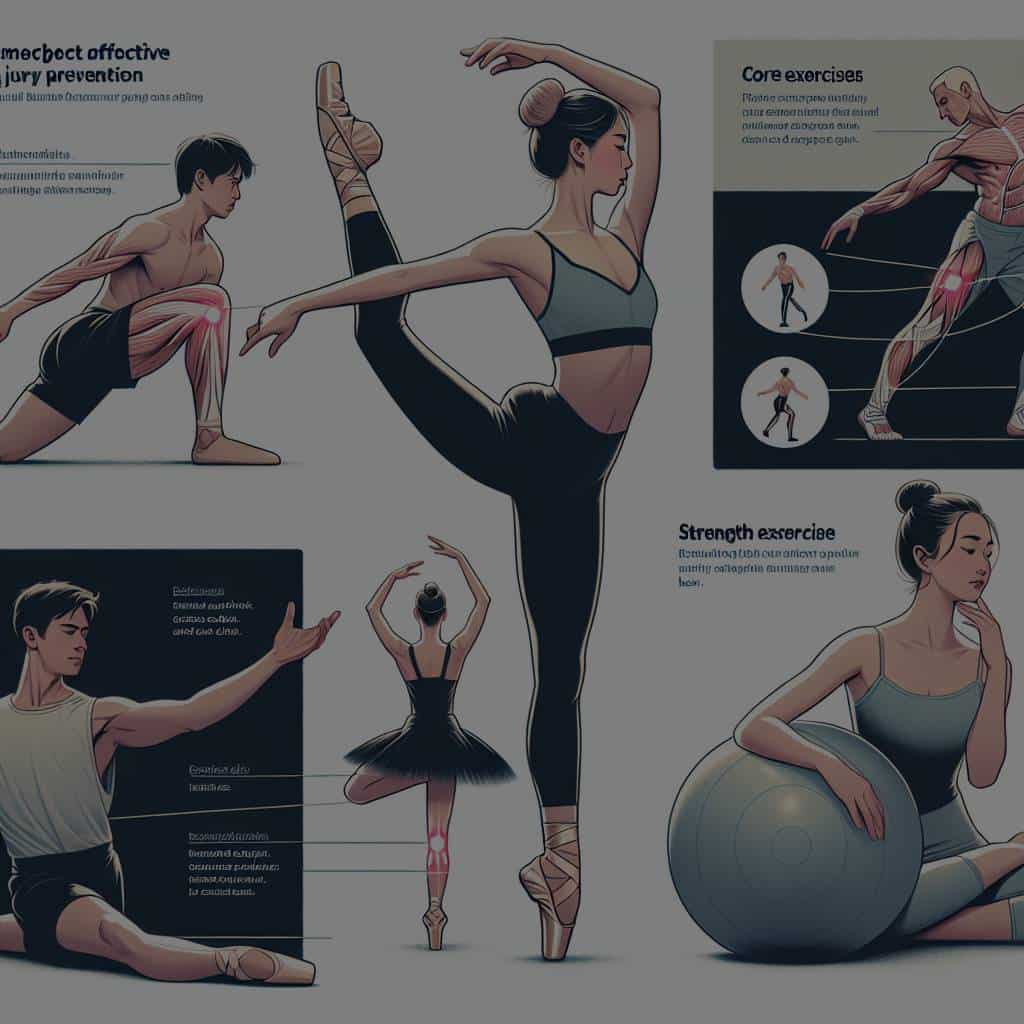What Are the Most Effective Injury Prevention Exercises for Professional Ballet Dancers?

Ballet, a world-renowned art form, is characterized by its grace and poise. However, beneath its alluring veneer lies a grueling regime that places a significant physical demand on dancers. This article targets professional ballet dancers, offering insight into injury prevention exercises backed by scholarly resources on databases such as Google Scholar and PubMed. We’ll explore the most common injuries dancers face, associated prevention methods, and strength-building exercises all aimed at ensuring a healthy, injury-free ballet journey.
The Dance of Injuries in Ballet
Ballet dancers are similar to sports athletes in terms of the physical stress they endure. It’s not uncommon for dancers to sustain injuries, which can range from mild sprains to severe fractures, mainly targeting the foot, leg, and hip.
A lire également : What’s the Impact of Altitude on Sprint Performance in Track Athletes?
According to studies referenced on Google Scholar and PubMed, foot and ankle injuries are the most prevalent. These injuries result from the foot’s biomechanics, particularly those that involve balancing on the tip of the toes, known as ‘en pointe’. Other common injuries involve the hip and leg, largely attributed to the extensive range of motion and extreme physical control required in ballet.
Preventing these injuries requires a thorough understanding of their causes and a rigorous commitment to prevention practices. This approach is crucial because, as any dancer knows, an injury can significantly impact a dancer’s career, potentially leading to long-term physical damage.
En parallèle : How to Develop a Sport-Specific Nutrition Plan for Competitive Weightlifters?
Building Strength for Injury Prevention
A key part of injury prevention involves building strength in key areas of the body. Studies suggest that a strong body is less prone to injury, and for dancers, this principle is particularly applicable to the lower body— the legs, hips, and feet.
Strength training will not only aid in preventing injuries but also enhance your dance performance. Exercises focusing on the lower body, such as squats, lunges, and calf raises, can help build strength and stability. Similarly, incorporating exercises targeting the hips, like hip bridges and clamshells, can offer improved control and flexibility, leading to fewer hip injuries.
It’s essential to consult with a trainer who understands the specific physical demands of ballet to ensure your strength training regimen is well-rounded and effective.
Exercises to Prevent Foot and Ankle Injuries
Foot and ankle injuries are a common occurrence in the life of a ballet dancer. Many of these injuries occur due to the strain placed on the foot and ankle while dancing en pointe.
Releve exercises can help strengthen the ankles and improve balance. While standing on one leg, you can rise onto your toes, hold the position for a few seconds, then lower yourself back down. Repeat this exercise, gradually increasing the duration and repetitions as your strength improves.
Balance exercises, such as standing on one foot or using a balance board, can also help to strengthen your ankles and improve your proprioception, thus reducing the risk of sprains and fractures.
Preventing Leg and Hip Injuries
Leg and hip injuries in ballet dancers often occur due to overuse or improper technique. Incorporating specific exercises into your routine can help minimize these risks.
For leg injuries, focus on exercises that strengthen your quadriceps, hamstrings, and calf muscles. Lunges, calf raises, and hamstring curls are all effective options. Regular leg exercises will yield stronger muscles capable of withstanding the rigors of ballet.
Hip injuries often occur due to the high range of motion and extreme positions required in ballet. Exercises such as hip bridges, clamshells, and hip flexor stretches can help condition your hips, increasing their strength and flexibility.
Dance Injury Prevention: The Bigger Picture
While specific exercises are crucial in injury prevention, it’s important to adopt a holistic approach. Ensure you get adequate rest and nutrition for your body to recover from the physical demands of ballet. Listen to your body and refrain from pushing yourself beyond your limits.
Furthermore, including regular physical check-ups in your routine can help detect any potential problems before they escalate into serious injuries. Participants in professional ballet companies should take advantage of any health and wellness resources available to them.
Remember, the prevention of injuries is always better than seeking a cure after the fact. It’s crucial that dancers prioritize their physical health to ensure longevity in their careers. Together with a well-rounded strength training regimen, rest, and proper nutrition, these exercises can help dancers avoid common injuries and continue to perform at their best.
Though the demands of ballet are high, with the right preventive measures, dancers can protect their bodies and continue to grace the stage with their captivating performances.
Remember, dance is a celebration of the human body’s capabilities. Let’s ensure we care for it as much as we push its boundaries.
Incorporating Flexibility Exercises for Injury Prevention
Flexibility is crucial for ballet dancers to perform complex movements and positions. According to articles found on Google Scholar and PubMed, improving flexibility can significantly decrease the injury risk. This is because greater flexibility in your muscles and tendons allows them to stretch and move without causing damage.
One of the best ways to improve flexibility is through regular streching. For professional ballet dancers, it is critical to do both dynamic and static stretches. Dynamic stretches, such as leg swings, arm circles or torso twists, are done in a controlled, gentle manner and the end positions are not held. They help to prepare the body for physical activity and increase body temperature.
Static stretches, on the other hand, are where muscles are elongated and then held in this extended position for a period of time. They are best done after exercising to help with muscle recovery and increasing flexibility. Examples of static stretches beneficial for ballet dancers include hamstring stretches, calf stretches, and hip flexor stretches.
Pilates and yoga are two disciplines that combine strength, control, balance and flexibility, making them fantastic complements to ballet. They offer a wide range of exercises and poses to enhance flexibility, core strength, and balance. These forms of training can help reduce the occurrence of common dance injuries and contribute to an overall stronger and more flexible body.
Remember, it is critical to ensure your stretching routine is performed correctly and tailored specifically to your needs as a professional ballet dancer. Consultation with a professional trainer can provide a more detailed and personalized flexibility regime.
Conclusion: The Path to Injury-Free Ballet
The world of professional ballet is undoubtedly physically demanding, with dancers pushing their bodies to the limit to deliver a flawless performance. With this, comes a high incidence of dance injuries, as referenced in several studies on Google Scholar and PubMed. However, with the right strategies, it is possible to significantly reduce the risk of injury and ensure a long, successful career.
Injury prevention is a matter of understanding the common risks and taking consistent, proactive steps to mitigate them. Regular strength training, targeted exercises to prevent foot, ankle, leg, and hip injuries, flexibility exercises and a holistic approach that includes adequate rest and nutrition are all vital components of an effective injury prevention strategy.
Remember, consistent practice of these injury prevention exercises is key. It’s important to start slow, listen to your body, and gradually increase the intensity and duration of your exercises. It is also advisable to work with a professional trainer to ensure your exercises are done correctly and tailored to your specific needs.
Finally, it is essential to consider the bigger picture when it comes to injury prevention. Professional dancers should take advantage of health and wellness resources available to them, including regular physical check-ups. These practices will help identify potential issues before they become significant problems. Ballet is a challenging yet rewarding art form, and with the right measures in place, dancers can protect their bodies while pursuing their passion.
As the saying goes, prevention is better than cure, and this could not be more true for professional ballet dancers. So let’s take heed, apply the knowledge we have, and ensure a future filled with injury-free performances. The stage awaits!
